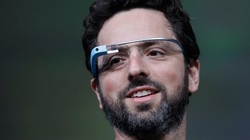
Google Glass is the brand name of a miniature computer worn on the head. It is mounted on a spectacle frame and hidden information in the visual field (Head-Up Display ). This information can be combined with the captured image, which has a built-in in the direction of the carrier digital camera delivers live. These data can be obtained directly from the internet and shipped. In the media-theoretical context, the technology is part of Augmented Reality. While Google Glass for some IT represents a technical milestone experts recognize data protection is far-reaching implications for the privacy of the user and the people around him. They oppose the introduction of the glasses because it is able to discreetly spy on the environment of the wearer and all records of all users transmit on Google's own servers.
Development
Google Glass is a research project from the Google Project Glass product derived product, in the so-called Google X division of the company with Sergey Brin, was developed. Name of Glass refers to the glass prism which fades the information in the field of view of the user. In English-speaking Glass is often mistaken as "due to the lexical proximity Glasses "(glasses), where Google CEO Larry Page is on the English singular "Glass": "It's only, Glass' because it's only on one side."
Reception
In November 2012, Glass received recognition by Time Magazine as one of the "Best Inventions of the Year 2012", alongside inventions such as the Curiosity Rover. After a visit to the University of Cambridge by Google's chairman Eric Schmidt in February 2013, Wolfson College professor John Naughton praised the Glass and compared it with the achievements of hardware and networking pioneer Douglas Engelbart. Naughton wrote that Engelbart believed that machines "should do what machines do best, thereby freeing up humans to do what they do best.”
Future Growth
Forward thinking, Google Glass is not likely to completely replace the cellphone. The spectacles are a barrier between normal human interactions; so many people will not want to wear them all the time. But it's obvious that Glass has huge applications in business and specific "experience" settings. Someone might want to wear Glass while at a concert, for instance, so they can enjoy the show again later. Or if they are a reporter on a remote assignment, their editors might want to see what they’re seeing. Protestors should use them on demonstrations to guard against police brutality.
But the killer app, at least initially, for Glass is likely to be photos. Glass photos make mobile phone photos look as labor-intensive as using an old-fashioned camera.
 RSS Feed
RSS Feed